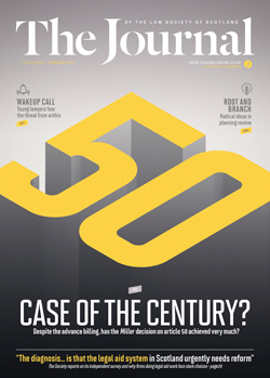Handcuffing of prisoners and article 3
Article 3 of the ECHR prohibits torture, inhumane or degrading treatment and punishment – an absolute prohibition that “enshrines one of the fundamental values of the democratic societies making up the Council of Europe”: Soering v United Kingdom (1989). In order to fall within article 3, treatment must satisfy a threshold test of a minimum level of severity. If it does, the question then becomes whether the circumstances amount to one of the prohibited categories (Reed and Murdoch, Human Rights Law in Scotland (3rd ed), para 4.63). Three decisions under article 3 have come from Edinburgh Sheriff Court over the past 20 months, all stemming from the same action.
The case of James McDowall
In 2013 James McDowall was serving nine years for attempted murder. On three occasions he attended hospital for examination, each time in the custody of officers employed by G4S. At hospital, G4S applied double handcuffs. While accepting that a measure of restraint was required, McDowall claimed that “double cuffing” was a breach of his rights under articles 3 and 8 of the ECHR and sought damages.
Domestic and European case law is clear that use of handcuffs does not normally give rise to an article 3 issue, taking into account the risks of the prisoner absconding or causing injury or damage. However, in the hospital context the use of handcuffs may constitute a disproportionate response to any perceived security risk in light of the prisoner’s health, and may violate article 3.
McDowall’s case went to debate before Sheriff Crowe (2015 SLT (Sh Ct) 129), to appeal before the Sheriff Principal (2016 SLT (Sh Ct) 107), and to proof before Sheriff Ross (2016 SLT (Sh Ct) 371). A brief consideration of each decision (focusing on the article 3 claim) follows.
At debate, the pursuer argued as respects the defenders’ pleadings that since no risk assessments had taken place prior to the hospital visits, the defenders did not respect his rights and feelings. On averments that he felt humiliated when taken through the public areas of the hospital while double cuffed, he sought declarator that his article 3 rights had been violated, and proof on quantum alone. Sheriff Crowe considered the defenders’ pleadings to have an “obvious flaw”, and granted declarator that the pursuer’s Convention rights had been violated.
Allowing the defenders’ appeal, the sheriff principal considered that the sheriff fell into error, first, by accepting that the risk assessment issue was fatal to the defenders’ case; and secondly, by “failing to notice” that the case law emphasises that the treatment complained of must meet the threshold test before falling within article 3.
Giving judgment after proof, Sheriff Ross noted that the “treatment must reach a minimum level of severity, and this is a high test… treatment which is unwelcome or unpleasant is not enough”. The pursuer offered to prove that he felt “humiliated and degrading” (sic) as a result of the double cuffing, when sitting in public waiting areas where children stared and parents pointed. Unfortunately the sheriff was unimpressed by his evidence, found that the double cuffing was reasonable and proportionate and held that the threshold test had not been met. There had been no infringement of the pursuer’s article 3 rights. Further, the defenders had, in fact, made an appropriate assessment of the overall risks on each transfer.
Discussion
Reed and Murdoch note that the threshold test “has been used to rein in any tendency to appear to trivialise article 3 by seeking to apply it to matters which arguably lack the requisite degree of seriousness at the historical heart of the article” (para 4.65). Here, the sheriff found that the pursuer had not proved how his feelings of humiliation would have been improved had he been single cuffed or uncuffed, but accompanied by more officers. “At best, the pursuer described exactly what one might expect from a prisoner under escort being taken through a public waiting area for treatment.”
These decisions are an important reminder of the hurdles a pursuer needs to overcome to succeed in an article 3 claim. In particular, the assessment of whether the treatment attains the minimum level of severity “depends on all the circumstances” (Mouisel v France (2004) 38 EHRR 34, where, in stark contrast to McDowall’s case, the applicant had been chained to a bed during chemotherapy sessions); and importantly, bearing in mind Sheriff Crowe’s reliance on the apparent absence of a risk assessment, “the focus of Strasbourg is not and has never been on whether a challenged decision or action is the product of a defective decision making process, but on whether, in the case under consideration the applicant’s Convention rights have been violated” (R v Governors of Denbigh High School [2007] 1 AC 100, per Lord Bingham).
In this issue
- Miller, Brexit and BreUK-up
- Power to the people?
- Prerogatives, Parliament and the constitution: plus ça change?
- Decisions in high places
- Reading for pleasure
- Journal magazine index 2016
- Opinion: Callum Sinclair
- Book reviews
- Profile
- President's column
- Have you heard of ScotLIS?
- People on the move
- Article 50: the final say
- Where courts fear to tread
- "Wake up": how young lawyers see the future
- How healthy is our legal aid system?
- Challenging assumptions
- Planning to deliver
- Contact and the fear factor
- And the bill goes to...?
- Pakistan to join Child Abduction Convention
- Dress to impress?
- Handcuffing of prisoners and article 3
- Turning up the heat on workplace change
- Scottish Solicitors' Discipline Tribunal
- Not just for the green welly brigade
- Five by five
- Law reform roundup
- Relief over pensions and bankruptcy ruling
- Helpline plus
- Spill the beans on legal aid fraud
- The art of bringing the good news
- Cybercrime: how are you protected?
- Ask Ash
- One year rule becomes three
- From the Brussels office






